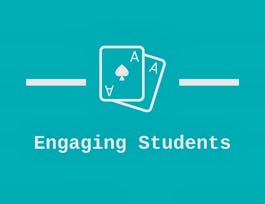Gamification is the application of game elements and digital game design techniques to non-game problems, such as business and social impact challenges. This course will teach you the mechanisms of gamification, why it has such tremendous potential, and how to use it effectively. For additional information on the concepts described in the course, you can purchase Professor Werbach's book For the Win: How Game Thinking Can Revolutionize Your Business in print or ebook format in several languages.


Gamification
Taught in English
Some content may not be translated
154,387 already enrolled
(2,406 reviews)
Skills you'll gain
Details to know

Add to your LinkedIn profile
5 quizzes
See how employees at top companies are mastering in-demand skills


Earn a career certificate
Add this credential to your LinkedIn profile, resume, or CV
Share it on social media and in your performance review

There are 6 modules in this course
Gamification is a new field, but games are ancient. In this first module, we'll look at what gamification is, why organizations are applying it, and where it comes from. While there isn’t universal agreement on the scope of the field, a set of concepts are clearly representative of gamification. The second lesson explains why the concept of games is deeper than most people realize, and how game design serves as a foundation for gamification.
What's included
12 videos1 reading1 quiz
What exactly does it mean to apply game design principles in non-game contexts? In this module, we'll discuss how game designers approach their craft, and how to see any situation through the lens of game design. Then we'll examine the raw materials of games and gamification, known as game elements. We'll earn how to break down a game into its constituent parts and apply them to create gamified systems.
What's included
11 videos1 quiz1 peer review
Gamification is a technique for motivation, so it ties very directly into psychology. This unit introduces the major psychological concepts relevant to gamification. The first lesson focuses on behavioral approaches and reward design; the second identifies the risks and alternatives to this approach.
What's included
10 videos1 quiz1 peer review
Gamification done well is a form of design. This module describes the design process, and provides a six-step framework to apply to any gamification project. The second lesson identifies important considerations and options for developing creative, human-centered, thoughtful gamification solutions.
What's included
10 videos1 reading1 quiz
This module describes particular challenges and opportunities when applying gamification in two contexts: within an organization, and in social impact or behavior change environments.
What's included
11 videos1 reading1 peer review
There are many legitimate limitations, concerns, and dangers from gamification. Some of them can be avoided through thoughtful design, but others must be considered directly in any implementation. The final lesson details gamification-related techniques that go beyond those covered throughout the course, and concludes with a look toward the future.
What's included
11 videos1 quiz
Instructor

Offered by
Recommended if you're interested in Design and Product

Erasmus University Rotterdam

Coursera Project Network

Yale University

Alfaisal University | KLD
Why people choose Coursera for their career




Learner reviews
Showing 3 of 2406
2,406 reviews
- 5 stars
82.34%
- 4 stars
14.37%
- 3 stars
1.99%
- 2 stars
0.66%
- 1 star
0.62%
New to Design and Product? Start here.

Open new doors with Coursera Plus
Unlimited access to 7,000+ world-class courses, hands-on projects, and job-ready certificate programs - all included in your subscription
Advance your career with an online degree
Earn a degree from world-class universities - 100% online
Join over 3,400 global companies that choose Coursera for Business
Upskill your employees to excel in the digital economy
Frequently asked questions
Access to lectures and assignments depends on your type of enrollment. If you take a course in audit mode, you will be able to see most course materials for free. To access graded assignments and to earn a Certificate, you will need to purchase the Certificate experience, during or after your audit. If you don't see the audit option:
The course may not offer an audit option. You can try a Free Trial instead, or apply for Financial Aid.
The course may offer 'Full Course, No Certificate' instead. This option lets you see all course materials, submit required assessments, and get a final grade. This also means that you will not be able to purchase a Certificate experience.
When you purchase a Certificate you get access to all course materials, including graded assignments. Upon completing the course, your electronic Certificate will be added to your Accomplishments page - from there, you can print your Certificate or add it to your LinkedIn profile. If you only want to read and view the course content, you can audit the course for free.
You will be eligible for a full refund until two weeks after your payment date, or (for courses that have just launched) until two weeks after the first session of the course begins, whichever is later. You cannot receive a refund once you’ve earned a Course Certificate, even if you complete the course within the two-week refund period. See our full refund policy.


